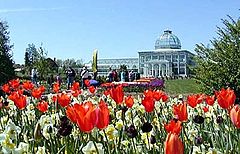Lewis Ginter Botanical Garden
| Lewis Ginter Botanical Garden | |
|---|---|
 |
|
| Type | Botanical |
| Location | 1800 Lakeside Avenue, Richmond, Virginia |
| Area | 50+ acres |
| Opened | 1984 |
| Collections | Conservatory, Rose Garden, Children's Garden, Sunken Garden, Asian Garden, Victorian Garden, Healing Garden |
| Website | http://www.lewisginter.org/ |
The Lewis Ginter Botanical Garden, 50 acres (200,000 m2), is a botanical garden located at 1800 Lakeside Avenue, on the North Side of Richmond, Virginia. It includes the Lakeside Wheel Club built by Lewis Ginter and expanded and remodeled into Bloemendaal by his niece Grace Arents.
The Garden’s three-fold mission is (1) to provide education to the community about the plant world, (2) promote the best in horticulture and landscape design and (3) work toward the goal of being a leader in botanical and applied horticultural research.
The gently rolling terrain that is the site of Lewis Ginter Botanical Garden was once the hunting ground of Powhatan Indians. Known to the Powhatan as "Oughnum" this name underwent a number of modifications beginning in 1690, when Nathaniel Bacon, president of the Council of Virginia, granted James Moore of New Kent County a patent for 573 acres (2.32 km2) on "Uffnum Brook."
A prominent Quaker named John Pleasants was the new owner, followed by Thomas Williamson, who purchased the tract for less than 50 pounds in 1716; over the next 89 years ownership of the land remained, for the most part, in the Williamson family. Violence erupted in 1781 when Samuel Williamson’s home was pillaged by General Benedict Arnold’s Revolutionary War raid on Richmond. A dwelling, Oak Cottage, was built during this time, and a portion of the Williamson land along with this cottage was purchased by Virginia Governor Patrick Henry. in 1786. An outdoorsman, the liberty lover fished and hunted on the land, much as the earlier Native American inhabitants had done. He sold the parcel to James Thompson in 1788.
The Williamson ownership of the remaining property came to an end in 1805 when the tract, now called Ufton, was sold to John Robinson, a prominent lawyer. Robinson owned the land for 23 years and planted groves of trees and a peach orchard on the property, signaling the beginning of its destiny as a spot of horticultural significance. His brother, Anthony, indulged a comparable passion for plants at his home, Poplar Vale, now Byrd Park. The property, described as "healthy, well-watered, in a good neighborhood" was sold at auction in 1828, and over the next fifty-odd years its owners were successively, Newton Hill, James Hill, Jr., Nathaniel King and Mildred King Ladd.
On Mildred Ladd’s death, Ufton was divided among her heirs, and it was from one of these in 1884 that Major Lewis Ginter purchased the 10 acres (40,000 m2) which were to become the Lakeside Wheel Club, Bloemendaal Farm and Lewis Ginter Botanical Garden. The millionaire’s avid interest in planned, landscaped suburban development began during a visit to his company’s Australian office in 1888. The attractive residential developments in Adelaide, Sydney and Melbourne prompted Major Ginter’s desire to create the same settings in Richmond.
...
Wikipedia
